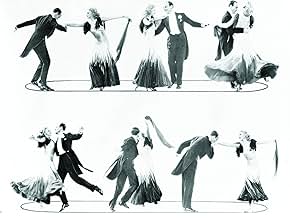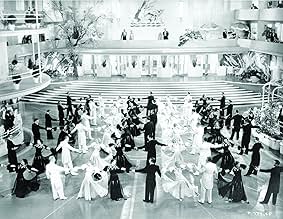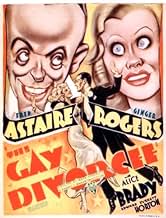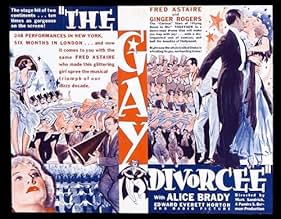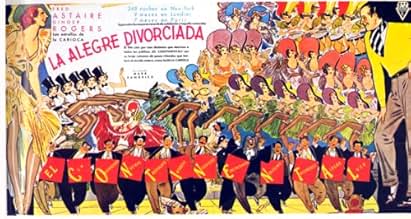IMDb RATING
7.3/10
9.1K
YOUR RATING
A woman thinks a flirting man is the co-respondent her lawyer has hired to expedite her divorce.A woman thinks a flirting man is the co-respondent her lawyer has hired to expedite her divorce.A woman thinks a flirting man is the co-respondent her lawyer has hired to expedite her divorce.
- Won 1 Oscar
- 4 wins & 5 nominations total
Norman Ainsley
- Undetermined Role
- (uncredited)
Jimmy Aubrey
- Undetermined Role
- (uncredited)
Finis Barton
- Undetermined Role
- (uncredited)
Eleanor Bayley
- Dancer
- (uncredited)
De Don Blunier
- Chorus Girl
- (uncredited)
Pokey Champion
- Dancer
- (uncredited)
Jack Chefe
- Night Club Patron
- (uncredited)
Featured reviews
Fred and Ginger, two perfect partners, two of the best dancers in history. In 1934, the toast of RKO. What a great pair the studio that would become defunct in a matter of years had on their hands!
In 1933, the pair had proven themselves as second leads in "Flying Down to Rio", a musical heavily relying on special effects and little else. They stole the show, proven with "The Carioca", the erotically charged dance number which started an American craze of pressing foreheads and even got the Best Song Oscar nod over the supposed show stopping title song. Before, Ginger had "42nd Street" to her name, while Fred had the famous screen test analysis of "Can't sing. Can't act. Can dance a little."
"The Gay Divorcee" is the establishing musical of Astaire and Rogers. Silly, dated, slight, even stupid to a certain degree is the entire story. Without a doubt, high comedy and immense creativity make up for it. The mistaken identity plot was recycled for "Top Hat" the following year, but it hardly matters. It is littered entirely with hilarity! Writing was never the strongest point of these musicals anyway. The performances were not Oscar calibre but they were publicly loved, and it's obviously Astaire and Roger's singing, acting and most of all, dancing, that makes the movie what it is.
A top wealth of talent was assembled for the movie. Erik Rhodes is absolutely side splitting as the Italian guy Tonetti, wielding the fabulous line, "Your wife is safe with Tonetti, he prefers spaghetti!". Alice Brady is there as Aunt Hortense, but Edward Everett Horton is another stand out performer as the lawyer. His fumbling voice provides a character of clumsiness and two seem to go hand in hand. He was definitely one of the best supporting comedians of the 1930s and 1940s, in other Astaire and Rogers musicals, and movies like "Lost Horizon", "Holiday", "Here Comes Mr Jordan" and "Arsenic and Old Lace".
Only one song was retained for the filmic version of "The Gay Divorcee". The censors even crashed down on the stage's original title "The Gay Divorce". Fred performs a great rendition of the immortal Cole Porter song "Night and Day". "The Continental", the Best Song of 1934 is thrown there in the mix too. Other great numbers in there include "Looking for a needle in a haystack", "Don't Let it Bother You" and "Let's K-nock- K-nees". The latter is performed by a young Betty Grable. This is notable for the only time Edward Everett Horton sings and dances on screen. We can see from the results there's an obvious reason.
The stylish period of courtship and even set decoration and costumes evoke great memories of eras gone by. RKO hasn't helped preservation of these technical elements by throwing what always appears to be mediocre sets, but it doesn't matter anyway. The whole thing is irresistible, spectacular and unforgettable. This is one of the forgotten musicals of the time which has it all.
Rating: 8/10
In 1933, the pair had proven themselves as second leads in "Flying Down to Rio", a musical heavily relying on special effects and little else. They stole the show, proven with "The Carioca", the erotically charged dance number which started an American craze of pressing foreheads and even got the Best Song Oscar nod over the supposed show stopping title song. Before, Ginger had "42nd Street" to her name, while Fred had the famous screen test analysis of "Can't sing. Can't act. Can dance a little."
"The Gay Divorcee" is the establishing musical of Astaire and Rogers. Silly, dated, slight, even stupid to a certain degree is the entire story. Without a doubt, high comedy and immense creativity make up for it. The mistaken identity plot was recycled for "Top Hat" the following year, but it hardly matters. It is littered entirely with hilarity! Writing was never the strongest point of these musicals anyway. The performances were not Oscar calibre but they were publicly loved, and it's obviously Astaire and Roger's singing, acting and most of all, dancing, that makes the movie what it is.
A top wealth of talent was assembled for the movie. Erik Rhodes is absolutely side splitting as the Italian guy Tonetti, wielding the fabulous line, "Your wife is safe with Tonetti, he prefers spaghetti!". Alice Brady is there as Aunt Hortense, but Edward Everett Horton is another stand out performer as the lawyer. His fumbling voice provides a character of clumsiness and two seem to go hand in hand. He was definitely one of the best supporting comedians of the 1930s and 1940s, in other Astaire and Rogers musicals, and movies like "Lost Horizon", "Holiday", "Here Comes Mr Jordan" and "Arsenic and Old Lace".
Only one song was retained for the filmic version of "The Gay Divorcee". The censors even crashed down on the stage's original title "The Gay Divorce". Fred performs a great rendition of the immortal Cole Porter song "Night and Day". "The Continental", the Best Song of 1934 is thrown there in the mix too. Other great numbers in there include "Looking for a needle in a haystack", "Don't Let it Bother You" and "Let's K-nock- K-nees". The latter is performed by a young Betty Grable. This is notable for the only time Edward Everett Horton sings and dances on screen. We can see from the results there's an obvious reason.
The stylish period of courtship and even set decoration and costumes evoke great memories of eras gone by. RKO hasn't helped preservation of these technical elements by throwing what always appears to be mediocre sets, but it doesn't matter anyway. The whole thing is irresistible, spectacular and unforgettable. This is one of the forgotten musicals of the time which has it all.
Rating: 8/10
The superb Fred and Ginger series always ended with a big, big set piece where the two of them could dance, and 'The Gay Divorce(e)' is no exception. This time it is 'The Continental', which allows half of what passes for Brighton to join in the dance.
Not the most original of plots, this movie teamed the leads together for the second time (the first time they led the cast though). Both are terrific, and Fred's dancing throughout is a treat. Ginger is her usual bouncy self, all wisecracks and big eyes, and good on her feet. They're ably supported by Edward Everett Horton (as 'Aunt' Egbert), Alice Brady (the towering matriach, Rogers' aunt), Eric Blore (as an irritating waiter who likes talking about rocks and playing with words), Erik Rhodes (as a daft Italian), and Betty Grable (as a hotel guest who has a terrific number with Horton, 'Let's K-knock K-knees').
As you might guess, the story revolves around a divorce, which might be a gay one (in the 1930s definition of the word, of course), and, as so often in this series, mistaken identities. Tiny roles go to William Austin (as Rogers' blustering geologist hubby), and Lilian Miles (an Alice Faye lookalike who gets to reprise 'The Continental' all to herself).
This is one of the better entries in the series, ably directed by Mark Sandrich, and featuring a mix of songs including Cole Porter's 'Night and Day', and the jaunty 'Looking for a Needle in a Haystack'.
Not the most original of plots, this movie teamed the leads together for the second time (the first time they led the cast though). Both are terrific, and Fred's dancing throughout is a treat. Ginger is her usual bouncy self, all wisecracks and big eyes, and good on her feet. They're ably supported by Edward Everett Horton (as 'Aunt' Egbert), Alice Brady (the towering matriach, Rogers' aunt), Eric Blore (as an irritating waiter who likes talking about rocks and playing with words), Erik Rhodes (as a daft Italian), and Betty Grable (as a hotel guest who has a terrific number with Horton, 'Let's K-knock K-knees').
As you might guess, the story revolves around a divorce, which might be a gay one (in the 1930s definition of the word, of course), and, as so often in this series, mistaken identities. Tiny roles go to William Austin (as Rogers' blustering geologist hubby), and Lilian Miles (an Alice Faye lookalike who gets to reprise 'The Continental' all to herself).
This is one of the better entries in the series, ably directed by Mark Sandrich, and featuring a mix of songs including Cole Porter's 'Night and Day', and the jaunty 'Looking for a Needle in a Haystack'.
Following an apparently accidental teaming in 1933's Flying Down to Rio (a fun Dolores Del Rio vehicle), Fred and Ginger got their first starring feature a year later. It was based on J. Hartley Manners' play 'The Gay Divorce'. The Hays Office insisted on shoving an 'e' on the end, for how could a divorce be so trifling as to be gay? Some UK prints still run with the original title. RKO assembled a sparkling ensemble cast of top-flight farceurs, bringing together (in ascending order of sublimity) Eric Blore, Edward Everett Horton and Erik Rhodes ("Are you a union man?"). Mark Sandrich directs the thing with a maximum of fuss and style. Hermes Pan helped Fred choreograph the numbers.
The plot is suitably - and delightfully - trivial. Musical star Guy Holden (Fred) happens upon a girl (Ginger), falls desperately in love with her, then spends the rest of the picture trying to free himself from marvellously silly plot threads and Everett Horton's exquisite quadruple-takes.
Keeping just one song from Cole Porter's original score, the timeless 'Night and Day', and adding only four others, The Gay Divorcée is more a comedy with songs than it is a musical comedy. But what comedy - and what songs! 'Looking For a Needle in a Haystack' is a masterpiece of economy: Fred a whirlwind of frustrated, lovestruck energy as he spins around his hotel room lamenting his missing love in peerless style. "Men don't pine," he memorably concludes, "Women pine. Men ... suffer." Everett Horton's rare excursion into song-and-dance territory is a breath of hysterical, liberating ludicrousness, as he knocks knees with a young Betty Grable. 'Don't Let It Bother You', performed by a chorus of dancing girls (and dolls), then spectacularly reprised by a tapping Astaire, is another treat. 'The Continental', the film's vast production number is peculiarly edited but sporadically fine and offers a fitting climax.
It's exceptional fluff, the sort of heady, heightened escapism that you don't come close to very often. An extravagantly mounted, joyous comedy played to perfection by two stars at their irresistible peak. Unmissable.
The plot is suitably - and delightfully - trivial. Musical star Guy Holden (Fred) happens upon a girl (Ginger), falls desperately in love with her, then spends the rest of the picture trying to free himself from marvellously silly plot threads and Everett Horton's exquisite quadruple-takes.
Keeping just one song from Cole Porter's original score, the timeless 'Night and Day', and adding only four others, The Gay Divorcée is more a comedy with songs than it is a musical comedy. But what comedy - and what songs! 'Looking For a Needle in a Haystack' is a masterpiece of economy: Fred a whirlwind of frustrated, lovestruck energy as he spins around his hotel room lamenting his missing love in peerless style. "Men don't pine," he memorably concludes, "Women pine. Men ... suffer." Everett Horton's rare excursion into song-and-dance territory is a breath of hysterical, liberating ludicrousness, as he knocks knees with a young Betty Grable. 'Don't Let It Bother You', performed by a chorus of dancing girls (and dolls), then spectacularly reprised by a tapping Astaire, is another treat. 'The Continental', the film's vast production number is peculiarly edited but sporadically fine and offers a fitting climax.
It's exceptional fluff, the sort of heady, heightened escapism that you don't come close to very often. An extravagantly mounted, joyous comedy played to perfection by two stars at their irresistible peak. Unmissable.
Guy Holden, the celebrated stage dance star, is touring Europe on vacation. Mimi Glossop is a rich American living in London and is currently in the throes of a divorce. They meet, they dance, they fall in love.
Ginger Rogers was by far the bigger cinema star when RKO Radio teamed her with Fred. She had appeared in 34 films to his 3, and two in the previous year had been smash hits - "Golddiggers" and "42nd Street". This loose borrowing from Cole Porter's Broadway show contains only one of the master's songs, the immortal "Night And Day", and only four other songs in the entire movie - Conrad & Magidson's "Needle In A Haystack" and "The Continental", and Gordon & Revel's "Don't Let It Bother You" and "Let's K-nock K-nees" (featuring an 18-year-old Betty Grable, who had herself featured in no less than eight films in the previous year).
At the depth of the Depression, this sort of film was all the rage - a fantasy of carefree opulence and ease, set in a world of Parisian floorshows, ocean liners and tuxedos. The wit is sharp and the mood flirtatious. What if the film-makers hadn't the first clue about how an English barrister conducts his cases? This is about romance, not professional ethics. What if the terrain of Brighton isn't an igneous intrusion, but in fact a sedimentary accretion? This is about two people's sublime dancing, not geology.
Fred is as always the quintessence of style, a naturally elegant creature, and Ginger is gorgeous. The plot is very well constructed, containing all the misunderstandings associated with musical farce, but developing them with panache. The denouement is both neat and unexpected. There are plenty of girls dancing in the usual geometric patterns, but there is also abundant creativity in the choreography - the playful steps in "The Continental", for example, or Fred's reluctant dance for his supper. Mimi is trying to resist Guy, and has to be drawn into "Night And Day" against her will - an instance of character being expressed through dance. Max Steiner's arrangement of this number is glorious, with its 'tacit', and the swelling fortissimos, and a dainty countermelody in the strings. Ginger sings "The Continental" like an angel, nicely ragging the time.
Inconsequential? No doubt. Frothy? Certainly. A joy to watch? Definitely!
Ginger Rogers was by far the bigger cinema star when RKO Radio teamed her with Fred. She had appeared in 34 films to his 3, and two in the previous year had been smash hits - "Golddiggers" and "42nd Street". This loose borrowing from Cole Porter's Broadway show contains only one of the master's songs, the immortal "Night And Day", and only four other songs in the entire movie - Conrad & Magidson's "Needle In A Haystack" and "The Continental", and Gordon & Revel's "Don't Let It Bother You" and "Let's K-nock K-nees" (featuring an 18-year-old Betty Grable, who had herself featured in no less than eight films in the previous year).
At the depth of the Depression, this sort of film was all the rage - a fantasy of carefree opulence and ease, set in a world of Parisian floorshows, ocean liners and tuxedos. The wit is sharp and the mood flirtatious. What if the film-makers hadn't the first clue about how an English barrister conducts his cases? This is about romance, not professional ethics. What if the terrain of Brighton isn't an igneous intrusion, but in fact a sedimentary accretion? This is about two people's sublime dancing, not geology.
Fred is as always the quintessence of style, a naturally elegant creature, and Ginger is gorgeous. The plot is very well constructed, containing all the misunderstandings associated with musical farce, but developing them with panache. The denouement is both neat and unexpected. There are plenty of girls dancing in the usual geometric patterns, but there is also abundant creativity in the choreography - the playful steps in "The Continental", for example, or Fred's reluctant dance for his supper. Mimi is trying to resist Guy, and has to be drawn into "Night And Day" against her will - an instance of character being expressed through dance. Max Steiner's arrangement of this number is glorious, with its 'tacit', and the swelling fortissimos, and a dainty countermelody in the strings. Ginger sings "The Continental" like an angel, nicely ragging the time.
Inconsequential? No doubt. Frothy? Certainly. A joy to watch? Definitely!
Quoting the Eric Blore/Alice Brady interchange in the restaurant, this movie is indeed whimsical (or "whumsical") and beautiful to boot. There probably has never been a more perfect dance than "Night and Day"....or a more beautiful song to dance to. That is the highlight of this film, although the rest of it is well worth seeing. Erik Rhodes is absolutely hilarious as the paid correspondent and the humor is not dated which is unusual in a film of this age. The "Chance is a fool's name for fate" routine is priceless. Edward Everett Horton again proves that he is the originator of the befuddled sidekick without being irritating and his little "dance" with a very young Betty Grable is such fun The art deco sets and great 30's clothes are wonderful and it makes you wish for a time when everybody wore evening dress and danced at the drop of a hat. Don't miss it...this is one of the highlight Astaire/Rogers efforts.
Did you know
- TriviaThe musical number "The Continental" lasts 17 1/2 minutes, the longest number ever in a musical until Gene Kelly's 18 1/2-minute ballet at the end of Un Américain à Paris (1951) 17 years later. It is also the longest musical number in all of Fred Astaire and Ginger Rogers' films together.
- GoofsDuring the car chase, Guy makes a quick turn on a dirt road, and a sound effect of squealing tires is heard. Tires do not make a squealing noise on dirt.
- Quotes
Tonetti: [unable to remember his passphrase "Chance is a fool's name for fate," Tonettie repeatedly muffs it] Chance is the foolish name for fate. / Give me a name for chance and I am a fool. / Fate is a foolish thing to take chances with. / I am a fate to take foolish chances with. / Chances are that fate is foolish. / Fate is the foolish thing. Take a chance.
- Alternate versionsIn the version of the movie released in Brazil in the 1930s, the Brazilian actor Raul Roulien sang in the musical number "The Continental".
- ConnectionsEdited into Jeanne de Paris (1942)
- SoundtracksDon't Let It Bother You
(1934)
Music and Lyrics by Mack Gordon and Harry Revel
Dance performed by Fred Astaire
- How long is The Gay Divorcee?Powered by Alexa
Details
- Release date
- Country of origin
- Official site
- Languages
- Also known as
- La alegre divorciada
- Filming locations
- Santa Monica, California, USA(Exterior)
- Production company
- See more company credits at IMDbPro
Box office
- Budget
- $520,000 (estimated)
- Gross worldwide
- $6,879
- Runtime
- 1h 47m(107 min)
- Color
- Aspect ratio
- 1.37 : 1
Contribute to this page
Suggest an edit or add missing content



